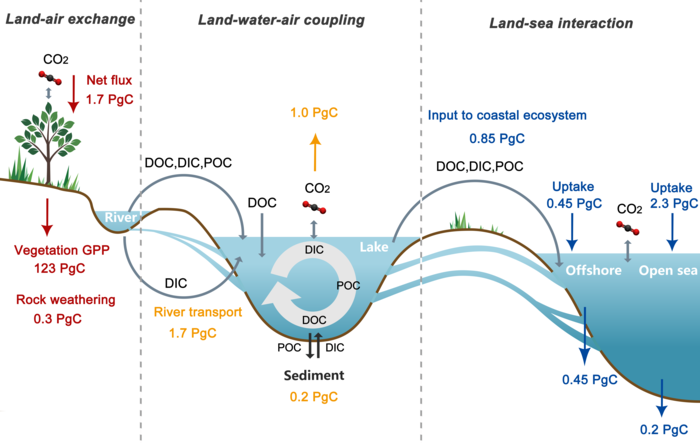Recent research headed by Professor Yu Guirui and Gao Yang’s group from the Institute of Geographic Sciences and Natural Resources Research, CAS examined global land-water-gas carbon transport and carbon budget variations and their impacting mechanisms.

Four components are involved in land-water-air interface C cycle processes (DIC, DOC, POC, and CO2) at three different interfaces (the water-land interface, the water-air interface, and the sediment-water interface). This process mainly includes the following sources: river and groundwater DOC, DIC, and POC inputs; river and groundwater DOC, DIC, and POC outputs; atmospheric DIC, DOC, and POC deposition inputs; and the absorption and emission of CO2. Photosynthesis, mineralization, and flocculation are the main factors that effectuate the mutual conversion of DIC, DOC, and POC. POC is deposited in sediment, and carbon is released from sediment. Carbon flux is equal to the carbon concentration multiplied by the carbon released. Image Credit: ©Science China Press.
The study concentrates on the significant role of an inland water carbon budget and the carbon cycle in the land–sea–gas carbon budget. Also, under global change, it discloses the regulation mechanism of land–water–gas carbon budget and carbon balance.
The current situation of land–water–gas carbon budget and lake carbon sequestration potential in China are also assessed.
The process of land–water–air coupling consists of the integrated importance of the four components involved in cycling processes concerning the association between land-air exchanges and land-sea interactions (DIC, POC, DOC and CO2) at three diverse interfaces (the water-air interface, the water–land interface, and the sediment-water interface).
Even though the conversion of CO2 from inland water systems to the air is an identified component of the global carbon cycle, there is no functional framework to evaluate global water surface area and gas exchange rates. There is also no existing global CO2 database.
The process of carbon fixation of inland water systems primarily consists of the transformation of inorganic carbon into organic carbon by plants via photosynthesis, sediment carbon fixation and water carbon fixation.
The transformation process between organic carbon and inorganic carbon pools primarily includes the following: emergent plants and floating leaf plants that directly tend to absorb atmospheric CO2, while phytoplankton utilizes aqueous CO2 and bicarbonate in water during photosynthesis, which effectually generates gross primary productivity; phytoplankton and emergent plants release CO2 directly to the air via respiration.
Also, phytoplankton and animal species liberate CO2 via respiration, which effectually generates the DIC discovered in inland water bodies; organic carbon can also be transformed into inorganic carbon via mineralization of organic carbon pools and microbial-induced degradation.
Climate change is considered a significant driver of riverine-based carbon transport processes, and dam construction, dredging, urban sewage discharge, waterway storage as well as other anthropogenic-derived activities have slowly become significant factors that impact carbon cycling, carbon sources and carbon budgets at the land-water-air interface.
Uncertainties and complexities accompanying carbon budget estimates at the land-water-air interface under global climate change make it hard to identify how natural or anthropogenic activities will impact the processes of carbon cycling.
Various driving factors are known to be impacted by anthropogenic activities, like land–water carbon flux and land–air and water–air carbon exchanges.
But it remains hard to quantitatively examine the effects of such anthropogenic activities on carbon flux. Comprehending the accurate direction and magnitude of several anthropogenic-induced impacts on the land-water-air interface carbon transport and carbon exchange processes is hence considered crucial to balance the global carbon budget and to quantify the global terrestrial carbon sink.
Journal Reference:
Gao, Y., et al. (2022) Carbon budget and balance critical processes of the regional land-water-air interface: Indicating the earth system’s carbon neutrality. Science China Earth Sciences. doi.org/10.1007/s11430-021-9883-3